Is Your Home Supporting You As You Age? Here’s How a Home Safety Assessment Can Help
You’ve built a life in your home — full of comfort, routines, and memories. It’s where you feel most like you. But as the years go on, even the most familiar space can start to challenge your balance, comfort, or independence.
That’s why more and more seniors are choosing to take a proactive step: a home safety assessment. It’s not about giving up control — it’s about staying in control.
What Is a Home Safety Assessment?
A home safety assessment is a room-by-room evaluation of your home, led by a certified aging-in-place specialist. At House Calls, we come to your home (or do a virtual assessment) to help identify risks — and more importantly — opportunities to make your space safer, more comfortable, and better suited to your needs.
We listen to how you live and move, and create a personalized safety report full of suggestions, from quick fixes to long-term planning.
What Do We Look At?
Entrances & Walkways
- Are steps clearly marked and evenly spaced?
- Could handrails, ramps, or non-slip surfaces improve safety?
- Is there sufficient lighting at night or during bad weather?
Bathrooms
- Would a grab bar, walk-in shower, or raised toilet seat increase safety?
- Are towel bars being used as support (which can be dangerous)?
- Is there enough contrast between walls, fixtures, and floors?
Kitchens
- Are frequently used items easy to reach?
- Could drawer pulls or knobs be replaced with easier-to-use options?
- Is flooring slip-resistant and level?
Living Areas & Bedrooms
- Is furniture positioned for easy movement with a walker or cane?
- Are rugs secured or removed to prevent tripping?
- Could lighting be adjusted for better visibility and night safety?
Door Handles, Knobs & Switches
- Are round knobs hard to turn? Lever-style handles may help.
- Are light switches reachable and easy to use?
Paint Colours & Contrast
- Poor contrast can make it harder to see depth or steps.
- We evaluate how colour schemes and lighting impact visual clarity, especially for those with cataracts or vision loss.
Stairs & Railings
- Are railings secure — on both sides if needed?
- Is there adequate lighting and clear edge visibility on each step?
Outside Spaces
- Are patios, driveways, and garden paths free of hazards?
- Could raised garden beds, outdoor handrails, or lighting make the space more usable and enjoyable?
Renovation Opportunities
We also identify areas where renovations might make sense — either now or in the future. This could include:
- Widening doorways for a walker or wheelchair
- Installing a walk-in tub or zero-threshold shower
- Lowering countertops
- Creating a main-floor living space if stairs become difficult
You’ll receive all this in a clear, prioritized report, so you can plan changes at your pace, based on your goals.
When Should You Get One?
You don’t need to wait for a fall, injury, or health scare. In fact, the best time to get a home safety assessment is before something happens. Think of it like getting your car serviced before a road trip — it’s about prevention, not panic.
Whether you’re fully independent or just noticing small changes in your vision, balance, or mobility, a home safety assessment can help you plan ahead with dignity and confidence.
Why It’s Worth It
At House Calls, we believe aging should be about living well, not limiting yourself. Most of the improvements we recommend are simple, affordable, and can be done without any major renovations.
We’ve helped many people like you stay in the homes they love — longer, and with fewer worries. Because we understand that staying safe at home doesn’t just protect your body… it protects your freedom.
Ready to Take the Next Step?
If you’re curious, let’s talk. We offer free, no-obligation calls to explain how it works and answer any questions.
👉 [Book a Free Call] or [Schedule Your Assessment Today]
Your home should support the life you want to live — we’re here to help make sure it does.

